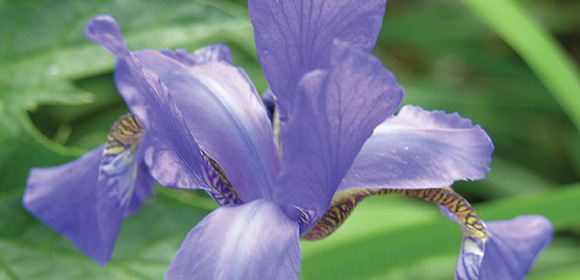Siberian irises are slender and delicate. Their elegant blooms rise a foot above narrow lashes of green foliage to signal the advent of early summer. The leaves, from two to four feet in height, are a good, strong green, growing in fountain-like clumps that last all summer and provide interesting textural contrast to more mounded and mundane plants.
In the past, Siberian irises were typically dark blue, navy, violet and purple. Today, there are pure whites, creamy whites, and yellows (‘Butter and Sugar’, ‘Butter and Cream’). While there are no true reds or pinks, there is promising progress in some hybrids such as the wine-red ‘Pink Haze’ and ‘Hubbard’.
All iris flowers have three inner petals called standards, which remain upright as the flower opens, and three outer petals called falls, which bend backwards and “fall” toward the ground. Three wider, style arms (really extensions of the ovaries and containing egg cells) radiate from the centre of the bloom. After pollination, these eventually become the seed pod.
A “beardless” iris, Siberians have smaller flowers and do not display the hairy, caterpillar-like appendage growing along the falls of their bearded cousins, although they do have semi-circular markings called a signal or blaze, which occurs at the flower base to attract pollinating insects.
In white flowers, signals are yellow, in modern hybrids, they are white or gold and in older Siberians, they are brownish. The blaze may also include a thin edging of gold or white around the falls as in ‘Golden Eagle’, a dappling or stippling over the falls as in ‘Ann Dasch’ or veins of yellow or green radiating down the falls from the blaze. Falls can be splashed with white lines and dots as in ‘Neat Trick’ or come bi-coloured or two-toned.
Siberian iris flowers are generally three to four inches across, although those with horizontal falls may reach as wide as five inches. The standards and falls are narrow and somewhat pointed and may be “crimped” with fine folds or pleats, or they may be tailored with no crimps or ruffles. In general, the shape of the petals presents a triangular form as seen in ‘White Triangles’. The flowers may be very open, that is with space between the falls or petals, or the petals may be wide enough to overlap creating a more rounded form.
Individual iris flowers last two to four days, while the entire clump will bloom 10 days to three weeks, depending on the number of flowers it has. Stalks may or may not branch to produce two flowers and in, rare cases, three. Siberians will bloom with as little as a half day of sunlight, although full sun is preferred. If it is too shady, they will refuse to flower. Early-, mid- and late-blooming hybrids are now available.
Quite long-lived, Siberian irises prefer moist, well-drained soil but can withstand short-term flooding. The small, thin rhizomes can be planted at a depth of one to two inches (unlike their bearded cousins, which need to be planted more shallowly) in early September. This is also the best time for dividing. Be aware that it sometimes takes a year before they will bloom again after division.
Irises reproduce by annual increase of rhizomes and they also produce seeds. Soil type is not a critical issue, but Siberians do prefer slightly acidic soils, so mix in plenty of compost or peat when planting. Apply fertilizer, 10-10-10, once or twice in spring and again after flowering.
Siberian irises are disease resistant, although in rare cases leaf scorch can occur, causing browning of the leaf and death of the fan. Leaf spot, caused by a fungus, (more common in bearded and spuria irises), is characterized by small brown spots on the leaves. While it will not kill the iris, severe infections can cause leaves to fall. Attacks of botrytis rhizome rot, botrytis blossom blight, crown rot and root rot can also occur on rare occasions. These are all best prevented by good gardening practices, including destroying infected plants and leaves. Yellowing of leaves may indicate a lack of iron or insufficient nitrogen. Cut back foliage and dispose of it in fall.
Of all the beardless irises, Siberian irises are the best suited to our cold climate, hardy from zones 3 to 10. They are easy to raise and easy to maintain. Siberian irises give the garden structural interest, charm and grace. No gardener should be without a clump or two.
Dorothy Dobbie is the publisher of Manitoba Gardener magazine. Subscriptions can be obtained by calling 204-940-2700 or online at localgardener.net.



